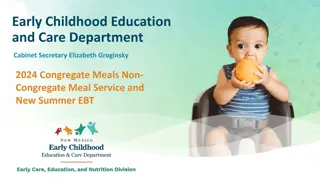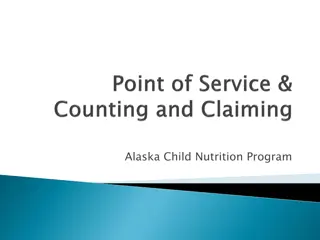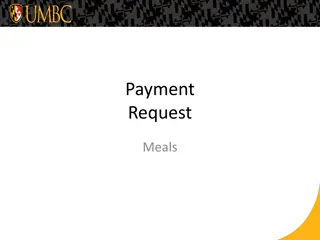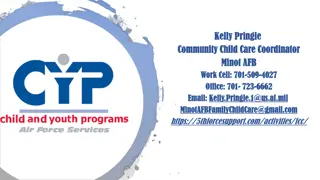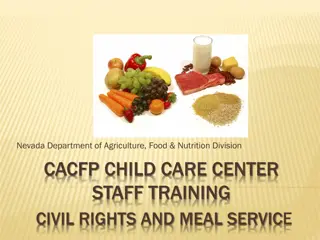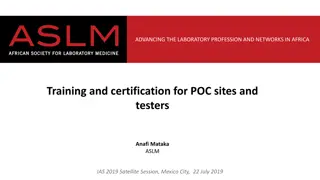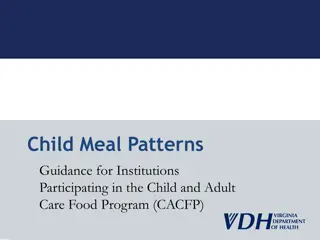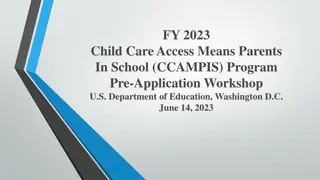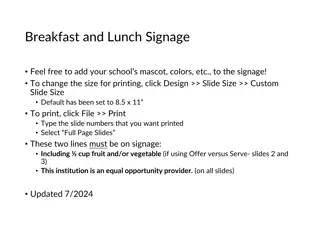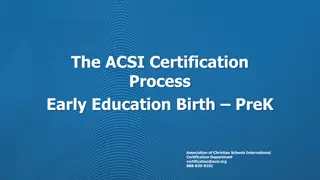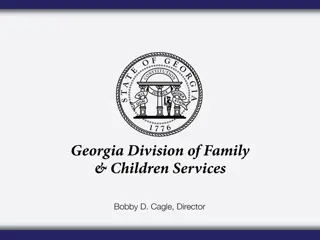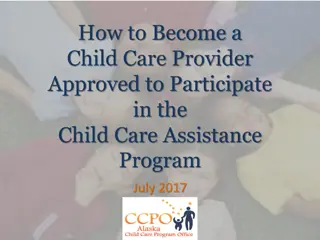Procedures for Residential Child Care Institutions and Meal Certification Programs
Explore the guidelines for Residential Child Care Institutions (RCCI) and certification processes related to free meal eligibility for residents. Learn about tracking training hours, maintaining documentation, and income verification requirements. Discover how to manage eligibility documentation, issuance of benefits, and procedures for students at RCCI.
Download Presentation

Please find below an Image/Link to download the presentation.
The content on the website is provided AS IS for your information and personal use only. It may not be sold, licensed, or shared on other websites without obtaining consent from the author. Download presentation by click this link. If you encounter any issues during the download, it is possible that the publisher has removed the file from their server.
E N D
Presentation Transcript
Residential Child Care Institutions (RCCI) & Jails
Professional Standards for State and Local Nutrition Program Personnel Final Rule Required to track the number of training hours earned each year and maintain documentation of the trainings attended SED prototype tracking Excel document
Certification Residents qualify for free meals Record eligibility using free and reduced-price application or an eligibility documentation sheet Eligibility documentation sheet must include the student s name, DOB, personal income, date of admission and date of release Day Students Students who do not reside at the RCCI Eligibility can be determined by direct certification or household application RCCI may request copy of free and reduced price meal application from regular school, if available
Benefit Issuance Document Master list of all eligible free and reduced-price students Indicate how the student was deemed eligible Direct Certification Categorical Eligible Free and Reduced Price Application Eligibility Documentation Sheet Resident s discharge date and time Point of Sale systems keep a hard copy of the master list at the registers
Income Verification Income verification Required for day students only Refer to Verification Booklet and applicable webinars Completion of Verification Collection Report (attachment G) is required annually, even if income verification was not required The report must be submitted to the State Agency by December 15th
For SFAs with No Day Students Section 1 will prefill once the October claim is submitted using the last operating day in October. Section 3-1 Check the box indicating that you were not required to perform direct certification
For SFAs with No Day Students Section 5-1 Check the box indicating that you are exempt from verification Completed by November 15th Submitted to SED by December 15th
Meal Counting & Claiming SFAs must establish a reliable system for counting, recording and claiming meals Meal counts should be based on reimbursement category Collection Methods Rosters Computerized Systems (Point of Sale Registers) Tic sheets For sites with only free eligibles
Meal Counting & Claiming Rosters Apply a uniform code for eligibility status A for Free, B for Reduced, C for Paid NOT F, R and P List all eligibility categories on one roster Rosters should be updated as changes occur Upon admission or discharge Check off student name on roster at the point of service (POS) After service, check marks are tallied, by category, to calculate the daily meal count Computerized System Electronically records the number of meals served to students Uses a programmed coding system Ensures anonymity of students Ensure back-up plan exists if systems were to go down Printed Coded Rosters
Point of Service Location and time that a student receives a reimbursable meal All the required meal components in the minimum required quantities must be on a student s tray before the meal can be counted as reimbursable It is essential that staff is trained to identify the components of a reimbursable meal Offer Versus Serve Point of Service count must be taken for all methods of meal service
Method of Meal Service & Accountability Method Meal Count Taken Afterall required components are offered and served Tray Line After Requiredcomponents are served Family Style After all required components are offered and served Buffet When students receive their meals Bag/Grab & Go Meals Accountability POS Reimbursable meal identification Proper counts by category One meal per child per meal service
Edit Checks Ensure that the meal counting and claiming system works properly Ensure the daily meal count does not exceed the number of eligible students SFAs are required to conduct edit checks of daily meal claims for all Recipient Agencies (RA) Verify meal count is accurate and compare the daily meal counts at each RA
Consolidation of Buildings/RAs NYSED will restructure RCCIs with multiple RAs that share the same address They will be combined into one RA for claiming purposes only Each consolidated RA will represent a separate POS Consolidation will: Simplify the administrative review process Reduce administrative paperwork NOT affect meal service
Meal Pattern and Nutritional Quality
Meal Components Breakfast Meal Components 1. Fruits/Vegetables 2. Grains/Meat and Meat Alternates 3. Fluid Milk Lunch Meal Components 1. 2. Vegetables 3. Grains 4. Meat/Meat Alternates (M/MA) 5. Fluid Milk Fruits Dark green Red/Orange Beans/Legumes Starchy Other
Seven Day School Week Meal Component Adjustment for Lunch Grades K Grades K- -5 5 Weekly (daily) Weekly (daily) Fruits (cups) 3.5 (0.5) Grades 6 Grades 6- -8 8 Weekly (daily) Weekly (daily) 3.5 (0.5) Grades 9 Grades 9- -12 Weekly (daily) Weekly (daily) 7 (1) 12 Grades K Grades K- -8 8 Weekly (daily) Weekly (daily) 3.5 (0.5) Lunch Lunch Vegetables (cups) 5.25 (0.75) 5.25 (0.75) 7 (1) 5.25 (0.75) Dark Green Red/Orange Beans/Peas (Legumes) Starchy Other Additional Grains (oz eq) Meats/Meat Alternate (oz. eq.) 0.5 0.75 0.5 0.75 0.5 1.25 0.5 0.75 0.5 0.5 0.5 0.5 0.5 0.5 2.5 11 (1) 0.5 0.5 2.5 11 (1) 0.5 0.75 3.5 14 (2) 0.5 0.5 2.5 11 (1) 11 (1) 12.5 (1) 14 (2) 12.5 (1) Fluid Milk (cups) 7 (1) 7 (1) 7 (1) 7 (1)
Seven Day School Meal Component Adjustment for Breakfast Grades K Grades K- -5 5 Weekly Weekly (daily) (daily) Grades 6 Grades 6- -8 8 Weekly Weekly (daily) (daily) Grades 9 Grades 9- -12 Weekly Weekly (daily) (daily) 12 Grades K Grades K- -8 8 Weekly Weekly (daily) (daily) Grades K Grades K- -12 Weekly Weekly (daily) (daily) 12 Breakfast Breakfast Fruits (cups) 7 (1) 7 (1) 7 (1) 7 (1) 7 (1) Grains (oz eq) 10 (1) 11 (1) 12.5 (1) 11 (1) 12.5 (1) Fluid Milk (cups) 7 (1) 7 (1) 7 (1) 7 (1) 7 (1)
Offer Versus Serve (OVS) at Breakfast OVS is optionalfor all age/grade groups Schools must offer all three required components in at least the minimum required amounts Schools must offer at least 4 food itemsfrom the three required components Students must select at least 3 food items, with one of the food items being at least cup of fruit and/or vegetable
OVS at Lunch OVS is only required for students in the 9-12 age/grade group, it is optional for all other age/grade groups Schools must offer all five required components in at least the minimum required amounts Students must take 3 components, one being cup of fruit and/or vegetable If a student chooses cup of fruit or vegetable, the other two components selected must be in the minimum required quantities to be considered reimbursable K-5 age/grade group selects cup carrots and 2 oz. eq. M/MA hamburger on 1.5 oz. eq. grain whole wheat bun Reimbursable! 9-12 age/grade group selects cup carrots and 2 oz. eq. M/MA hamburger on 1.5 oz. eq. grain whole wheat bun X Not Reimbursable!
Meal Service Styles Generally accepted meal service styles. Tray line Pre-set table setting Pre-plating Family Style
Age/Grade Waiver Memorandum SP38-2012 extends age/grade group flexibility of the lunch meal pattern to RCCIs and Jails With State approval, the SFA can offer the meal pattern of the highest age/grade group in attendance to all students
Age/Grade Waiver In order to utilize this flexibility, the RCCI or jail must meet all three of the following criteria: 1. Be a juvenile detention or correctional facility 2. Serve children in different age/grade groups; 3. Have legitimate safety concerns, or State juvenile justice laws or regulations related to offering meal(s) with varying amounts of food within the same meal period
Meal Pattern Compliance Tools SFAs need to retain records that show how planned meals contribute to the required meal pattern Child Nutrition (CN) Labels Exhibit A Product Formulation Statements Standardized Recipes Production Records
Exhibit A Exhibit A can be used to credit grains. Using Exhibit A (Example): Locate the correct category for the grain item on Exhibit A (B) Use the per serving weight of the product found on the nutrition fact label (29 g) Divide the weight of the product by the ounce equivalent column in Exhibit A (29/28 = 1.036) Always round down to the nearest quarter! (1 oz. eq.)
Standardized Recipes Standardized Recipes includes: Recipe Name Ingredients Weights and/or Measures Directions Yield
Production Records Daily documentation of what was planned, prepared and served at your foodservice operation Required for Breakfast, Lunch and Snack programs Necessary to support the claim Must Contain: Date Age/Grade Group School/Site Name Menu Item Recipe Number Portion Size Total Portions Offered Reimbursable Portions Served Non-Reimbursable Portions Served (adult meals, a la carte and second meals) Leftovers
Nonprofit School Food Service Account Indirect Costs Must be allowable cost Use approved rate from SED http://www.fns.usda.gov/indirect- cost-guidance Nonprogram Foods Second Meals Extra Items Non-reimbursable Meals Adult Meals
Procurement Importance Free, Open Competition Obtaining Best Possible Price
Procurement Plan Required by regulations Include in Plan Definitions Basic Organizational Concepts Specifications Buy American Minority/Women-Owned Businesses Conflict of Interest / Code of Conduct policy
Buy American Requirements Purchase domestic commodities and products that are produced in the US, or processed using agricultural commodities produced in the US. Include in all solicitation and contract documents Best Practices Country of origin on all products and invoices Specification in solicitations and contracts that only 100%domestically grown and processed products are approved for purchase
Buy American Limited Exceptions Consider alternatives first Other domestic sources Domestic substitution Time of year/availability Exceptions: last resort Insufficient quantities Competitive bid shows cost significantly higher Keep documentation to justify SED Monitoring Solicitation and contract documents Product labels Invoices/receipts Exception documentation
Which Regulation Applies? Non-public Schools and Charter Schools Federal Procurement Thresholds Micro Purchase-$10,000 Small Purchase- $250,000 Public Schools GML 103 small purchase threshold $20,000 Exceptions Emergency Sole Source
Written Procurement Procedures Determine procurement methods to be used Identifies parties that will address issues raised WRITTEN STANDARDS OF CONDUCT Conflicts of interest Prohibiting gratuities, favors May set standards for nominal value Disciplinary actions
Maintain Procurement Records Rationale for the method of procurement Selection of contract type Vendor selection or rejection Basis for the contract price Contract/agreement Delivery receipts Invoices Accounting records
SFA Procurement Review Procurement Policy/Standards Code of Conduct Summary of Expenditures In-depth review of selected procurements Review of written procurement procedures
General Program Compliance
CIVIL RIGHTS And Justice for All poster Non-discrimination statement Civil Rights training requirement- PowerPoint presentation Limited English Proficiency (LEP) Civil Rights Compliance Report-Not required if data is collected through district for other purposes (BEDS)
Non-Discrimination Statement All program materials must contain the most recent USDA non- discrimination statement The font of the statement may be decreased in size, however spacing must remain the same Statement must be on SFA s food service webpages SFAs are not required to include the USDA nondiscrimination statement on child nutrition menus or documents to other State agencies
Non-Discrimination Statement In accordance with Federal civil rights law and U.S. Department of Agriculture (USDA) civil rights regulations and policies, the USDA, its Agencies, offices, and employees, and institutions participating in or administering USDA programs are prohibited from discriminating based on race, color, national origin, sex, disability, age, or reprisal or retaliation for prior civil rights activity in any program or activity conducted or funded by USDA. Persons with disabilities who require alternative means of communication for program information (e.g. Braille, large print, audiotape, American Sign Language, etc.), should contact the Agency (State or local) where they applied for benefits. Individuals who are deaf, hard of hearing or have speech disabilities may contact USDA through the Federal Relay Service at (800) 877-8339. Additionally, program information may be made available in languages other than English. To file a program complaint of discrimination, complete the USDA Program Discrimination Complaint Form, (AD-3027) found online at: http://www.ascr.usda.gov/complaint_filing_cust.html, and at any USDA office, or write a letter addressed to USDA and provide in the letter all of the information requested in the form. To request a copy of the complaint form, call (866) 632-9992. Submit your completed form or letter to USDA by: (1) mail: U.S. Department of Agriculture Office of the Assistant Secretary for Civil Rights 1400 Independence Avenue, SW Washington, D.C. 20250-9410; (2) fax: (202) 690-7442; or (3) email: program.intake@usda.gov. This institution is an equal opportunity provider.
SFA On-Site Monitoring Must be completed prior to February 1st of each school year A copy of the SFA s On-Site Review forms Written documentation of follow-up to SFA reviews For any findings that require follow-up, the SFA is required to conduct a second self review of the site within 45 days to confirm the corrective action taken resolved the problems Written documentation to verify Corrective Action has occurred for any findings in the initial SFA review
Local School Wellness Policy Each SFA must establish a Local School Wellness Policy (LSWP) Made available for the public Reviewed and updated on a periodic basis by the LSWP committee Policies must include: Goals for nutrition education, physical activity, nutrition promotion and other school-based activities to promote student wellness Nutrition guidelines for all foods available on the school campus A plan for measuring implementation Designation of one or more officials in charge of school compliance oversight
Anti Meal Shaming Policies For Day Students Only
Professional Standards For State and Local Nutrition Program Personnel (Final Rule) Effective July 1, 2015 SFAs are required to track the number of training hours earned each year and maintain documentation of the trainings attended SFA must ensure compliance by maintaining: SED Tracking Tool USDA Tracking Tool
Professional Standards For Managers: At least 10 hours of annual continuing education/training For Full Time staff (work >20 hours/week): At least 6 hours of annual continuing education/training For Part-Time Staff (work <20 hours/week): Each year, at least 4 hours of annual continuing education/training, regardless of the number of part-time hours worked
Professional Standards For new directors hired after 7/1/15: Standards are based on SFA enrollment New directors must have at least 8 hours of food safety training within five years prior to their start date or within 30 calendar days after their start date At least 12 hours of annual continuing education/training
Water It is a responsibility of the SFA that children have access to free potable water during the lunch and breakfast meal services Any SFA that does not make free water available or restricts access during the meal periods is out of compliance While water must be made available to students, operators cannot promote or offer water or another beverage as an alternate selection to the fluid milk
Food Safety Hazard Analysis Critical Control Point (HACCP) Each site must have a written food safety plan for food preparation, service and storage facilities based on HACCP Standard Operating Procedures (SOP) Temperature Logs & Recording Includes food, refrigerator, and freezer temperature logs Proper Food Storage Food Safety Inspections A letter requesting at least two food safety inspections each school year from the health department must be sent A copy of the most recent health inspection report must be posted in a location that is visible to the public
Reporting & Record Keeping All reports must be accurate and submitted on time to NYSED Maintain records for 3 years plus the current year


